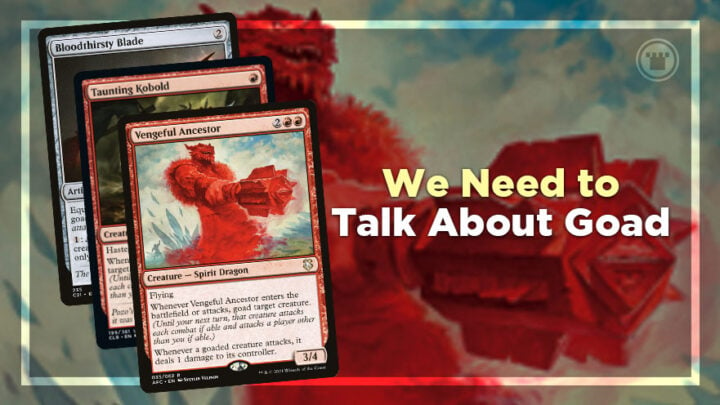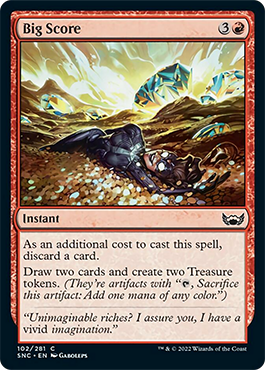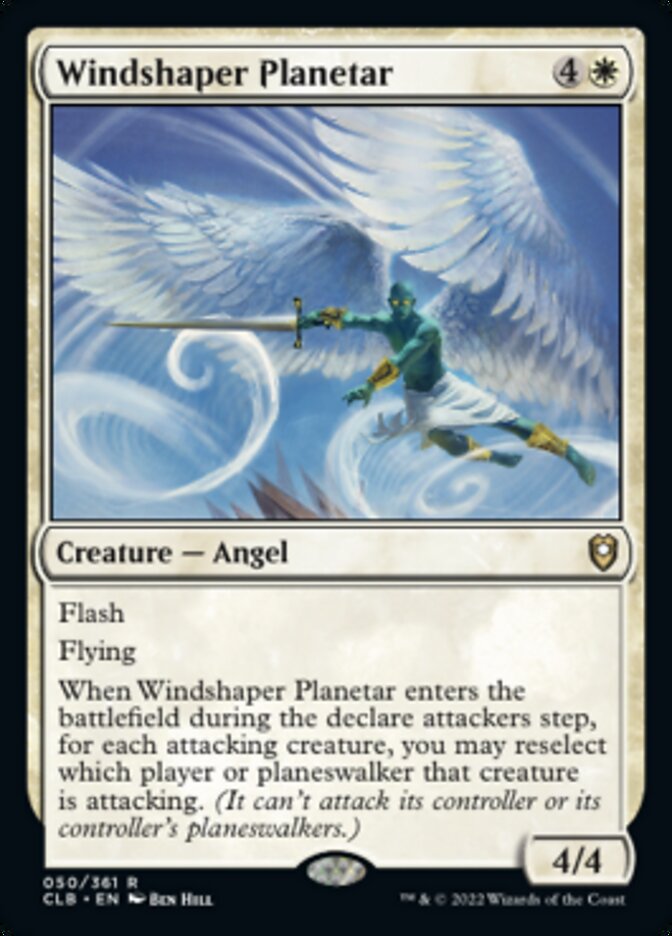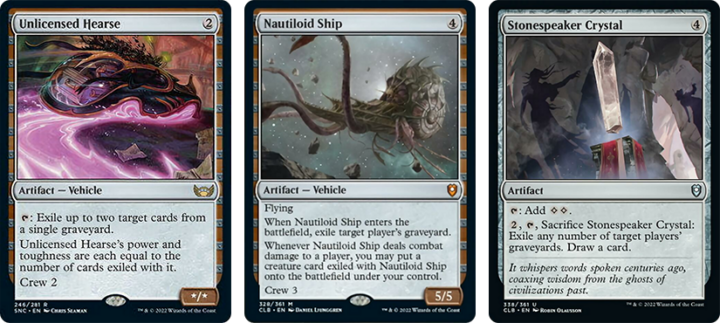Kristen returns this week with more than a few thoughts on Goad. She discusses its impact on Commander and some of the potential pitfalls of printing too much Goad.
Why was Goad introduced? To solve problems in multiplayer, basically. Goad was introduced in Conspiracy: Take the Crown, a multiplayer draft format (one that I hope sees another sequel before too long!). As a multiplayer draft format, this was the first, and Goad was one tool at Wizard’s disposal – another tool being Monarch – that could accelerate games to an end point. This is especially relevant in formats that have a limited card pool, like Draft or Sealed; decks are not optimized, and deterministic combos are rare, if present at all.
Does more Goad help games to end? Yes, it does. Is that a positive? It’s hard to say. In Limited, I think it is. In Commander? I think there’s more to it.
Critical Mass
Anything is great in moderation, and I’d argue that the best games of Commander are those where fun, splashy effects are exactly that – fun and splashy. A rogue Dawn Charm out of nowhere is a game-changing fog, and one you’ll love to tell the story about; a looped Spore Frog against decks that aren’t built to handle it is boring.
While deckbuilding can and does allow us to avoid some of the issues that arise with having a critical mass of a mechanic in the format, it can’t solve every issue, and that is no more obvious then it is with treasures. By and large, people are now a little cold on treasure. What started as a great way to help smooth out the draft and 1v1 experience – arguably more for Arena than anything else – has evolved into such a prevalent issue that people are seriously considering running Viridian Revel and effects like Stony Silence in decks aimed at casual tables.
The impact of having incidental treasure on commons and uncommons is perhaps greater than that of individual cards like Dockside Extortionist and Smothering Tithe, which can be easily subbed out to lower the power of a deck. Treasure is always present in a game, accelerates decks forward, smooths out mana issues, and is difficult to ever truly interact with, except by hosing other “fair” decks. If you’ve ever watched or taken part in Chat Chaos Commander – a kind of interactive Twitch-based game of Commander, where chat can use channel points to give treasure and card draw to players (amongst other effects) – you’ll know that early treasure can push a deck forward to a win it’s normally incapable of achieving.
Goad: Evergreen Mechanic
So, why is Goad now a potential issue? Because anything that you put enough of into a non-rotating format eventually hits the point where it becomes an issue. Commander Legends: Battle for Baldur’s Gate comes out soon, and the set is packed with Goad. The ethos is admirable, considering it’s aimed, again, at ensuring the draft experience is optimal. The end result, however, is pushing more aggressively costed Goad cards into a format already close to saturation.
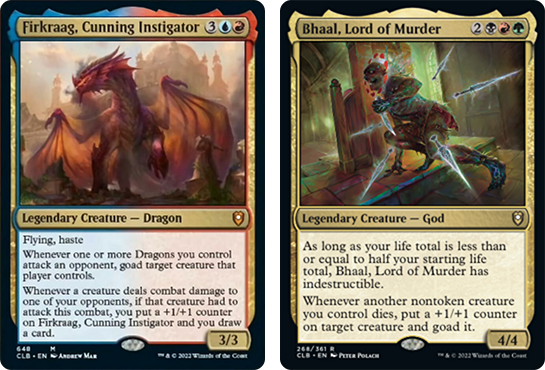
Firkraag and Bhaal, a precon Commander and one in the main set, respectively, are two pretty attractive new Commanders that care about Goad, and that’s not to mention Mazzy, Truesword Paladin who is secretly also a Goad Commander.
New Capenna Commander brought us two very potent Goad effects in the command zone, and they’re repeatable, too. Kitt Kanto, in all actuality, is a great hatebear style Commander, and should see more play than she’s currently seeing. Kitt and Kros weren’t the only Goad cards we got, though; Beamtown Bullies joins the ranks too.
With Kardur & Marisi already proving popular over time, and even Breena bringing a kind of proto-Goad effect to the table, it’s hard to avoid Goad in games. Goad Commanders are effectively kill-on-sight (save for Kardur, I guess), which, while the same for most new Commanders, is still indicative of how powerful Goad can be.
The Power of Goad
Monarch was and is a great mechanic. It introduces a small incentive to a game to encourage attacking, but still gives players decisions to make. Concessions to deckbuilding have to be made to ensure you retain it, and other decks who steal it might not have the right deck to ensure they keep it.
Goad, on the other hand, is much more than it seems on the surface. It’s not just a fog; it’s a way to kill opponents by spending minimal resources, and a way to have opponents use their own resources to avoid dying. The ceiling for goad is more than a 2-for-1: it’s a way to strip opponents of their board, their life totals, and the resources in their hand. With enough of it in your deck, you ensure your opponents kill each other, or stop commiting to the board at all. Either way, it benefits you.
Goad also makes turn order matter perhaps more than any other mechanic or rule in the game right now. By being last in turn order, you’ll have the least defenses, meaning Goaded creatures will invariably swing at you more often. Being punished for being last in the turn order has long been up for debate, but it feels like at a Goad-heavy table, you’re going to be in a really bad place.
With so much Goad, so many treasures, and plenty of cheap interaction to disincentivize board wipes, it feels like the format is being curated in a direction that might not satisfy the playerbase.
Goad is a Casual Problem
Goad isn’t an issue for cEDH, and for the most part isn’t an issue at high power tables with early combo wins. Goad is a uniquely casual problem, and one that is probably under the radar right now given how slowly feedback tends to bubble up from the wider casual playerbase.
The issue with Goad is that it’s an issue of agency. Agency in Commander is very important. Players invest time, money, and a little of their soul into their decks, and they want to feel like they had an impact on the game. While a lot of that boils down to having a well matched pod, a good chunk of it also remains in being able to make meaningful decisions.
Combat based casual decks that don’t have alternate wincons – whether aggro, midrange, reanimator etc – are heavily punished by a Goad heavy meta. They have decisions taken away from them, and an inability to make meaningful plays. The entire nexus of a casual beatdown deck is being able to enjoy the combat step; in choosing who is the threat, where to spend resources, and how to manage other players’ perceptions of your current board state. When Goad is thrown into every game, that agency is taken away, and those players suffer from a lack of agency.
Should people who build more casually be punished? No, because that’s the same as saying every player should be forced to endure chaos decks in casual EDH, because it’s “fun”. Not every player who builds casually wears the same hat in game, and just because they build at a lower power level doesn’t mean they don’t want to play optimally in game and enjoy that interplay.
The end point, if we keep adding Goad cards worth playing to the format, is that combat is less meaningful as a win condition. People will naturally gravitate toward more combo and control. Is that healthy for your playgroup? For the format?
What We Need
Currently the answers to the prevalence of Goad are all kinda anti-social. They involve running more pillowfort effects, more board wipes, more fogs, and more non-combat win conditions. I’m going to be bold here, and suggest that this could serve to speed the format up more than treasure ever could. I’ve said before that Goad is a uniquely Casual problem, and it’s a problem here in so much as it takes away one of the biggest parts of magic: combat involving meaningful decision making.
Combat is a core mechanic of the game. Combat is what makes Magic what it is, and it’s what makes other formats so interesting. It’s also what makes Commander interesting for a whole swath of players, players who see 120 life as a welcome challenge, who see keeping a board intact as a challenge, and who love to surprise opponents with a cheeky extra combat spell.
Right now, the format needs a way to cleanse Goad. I don’t think it’s playable as a one-off trick on its own; it needs to be stapled to the latest iteration of Akroma’s Will or Boros Charm. Hell, it could even be a red creature that prevents damage prevention and allows you to attack as if un-Goaded. We need a white hatebear that prevents your creatures being goaded. We need all of those things, because we need interplay.
Windshaping Celestial was so close. It doesn’t actually stop us having to attack, but it can help us reselect to be attacking the Goad-ee. It’s also five mana, though, and a lot of mana to hold up for a one-time EtB.
Essentially, we need some counterplay, just like every other strategy has counterplay. The amount of pushed graveyard hate lately is off the damn charts – just these few picks from SNC and CLB are easy to splash and provide more than enough value to justify their inclusion in a deck.
Wrap Up
Is the sky falling? No, and it rarely is. Goad can exist in the format as long as the right checks and balances exist. As it stands, adding more Goad and more attractive Goad-based Commanders to the format is, in my opinion, a net negative – at least until those counterplay cards exist.
Goad isn’t unsolvable by any means, and regular playgroups will talk and adjust as always. Is it yet another factor that has the potential to be detrimental to untrusted/LGS play? I think so, especially if the mechanic is now evergreen as Gavin says. I do think that if it is evergreen, though, we need some serious counterplay printed, and yesterday.
Ultimately we need to factor Goad into the equation, whether that’s in deckbuilding, threat assessment, or pre-game chats. Don’t be afraid to focus on the Goad player while you can, and don’t be put off if they try and sweet talk (or bully) you to not do so. In the same way you’d focus on a lifelink player when there’s no clear threat, you should expend resources on the Goad player while attacks are open.

Kristen is Card Kingdom’s Head Writer and a member of the Commander Format Panel. Formerly a competitive Pokémon TCG grinder, she has been playing Magic since Shadows Over Innistrad, which in her opinion, was a great set to start with. When she’s not taking names with Equipment and Aggro strategies in Commander, she loves to play any form of Limited.

